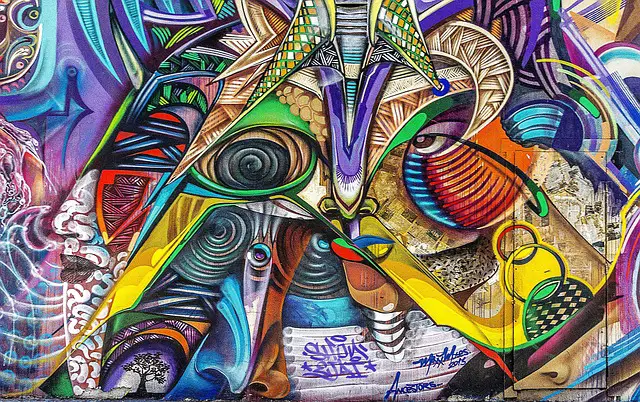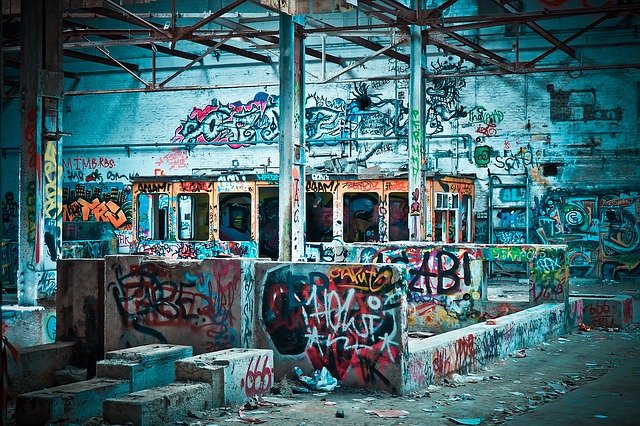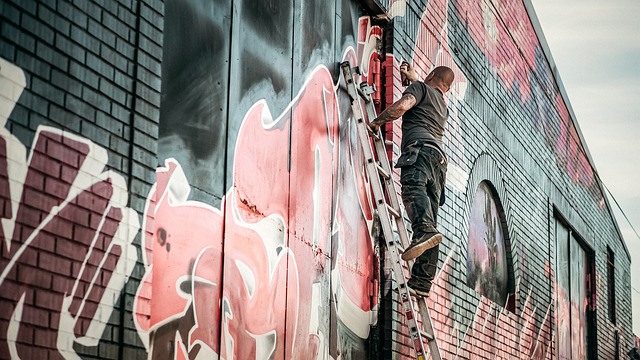Vandalism and street art have different definitions, though their lines can sometimes be blurred. Street art is a form of expression that is created with the intent of creating beauty, while vandalism typically involves an element of destruction or defacement. Though one may see similarities between them, it is important to distinguish between these two concepts to understand the difference between creative expression and criminal acts.
The definition of vandalism
The definition of vandalism is the willful or deliberate destruction, defacement, or damage to property without the permission of the owner. This can include graffiti, tagging, breaking windows, and other forms of property damage.
The definition of street art
(Image by ShonEjai from Pixabay )

Street art is a type of public art that is created in an unregulated and often unauthorized manner. Street artists typically use graffiti, stencils, stickers, wheatpaste posters, and street installations to make their art.
While street art is often associated with illegal activity, many street artists consider themselves to be engaged in a form of urban guerilla warfare or subvertising. They use their artwork to comment on social and political issues and to challenge the status quo.
Street art is often seen as a form of vandalism, but there is a big difference between the two. Vandalism is defined as the intentional destruction or defacement of property without the permission of the owner. Street art, on the other hand, is usually created with the permission of the property owner or with the tacit approval of the community.
What distinguishes street art from other forms of public art is its ephemeral nature. Street artists often work quickly and secretly, knowing that their artwork will only be up for a short time before it is removed or covered up. This makes street art a very dynamic and ever-changing form of expression.
The debate surrounding whether street art is considered vandalism
(Image by Hands off my tags! Michael Gaida from Pixabay )

The debate surrounding whether street art is considered vandalism or not has been going on for many years. Some believe that street art should be considered a form of vandalism, while others believe that it is a form of art.
There are a few reasons why some people may consider street art to be vandalism. One reason is that it can sometimes be associated with gang activity. Another reason is that it can often be seen as an eyesore, especially if it is done without permission from the owner of the property.
However, many people believe that street art is a form of art. They argue that it can add character and beauty to an otherwise bland cityscape. They also believe that it can be used to send positive messages to the community.
Is street art a glorified form of vandalism?
There is no clear consensus on the difference between vandalism and street art. Some people argue that street art is a more glorified form of vandalism, while others argue that the two are completely different.
Those who argue that street art is a more glorified form of vandalism typically point to the fact that street artists often use the public property without permission. They also often use spray paint and other materials that can be difficult to remove, which can cause property damage. Additionally, street artists often create their artwork in places where it may not be welcome, such as on buildings or other structures.
Those who argue that street art is not simply glorified vandalism typically point to the fact that many street artists create artwork with the permission of property owners. They also often use materials that can be easily removed, such as chalk or stickers. Additionally, many street artists create artwork in places where it is welcomed, such as in parks or on sidewalks.
Ultimately, whether or not street art is a more glorified form of vandalism is up for debate. What is clear, however, is that bo and street art can be seen as forms of self-expression.
What is the main difference between street art and graffiti
The main difference between street art and graffiti is that street art is usually considered to be more aesthetically pleasing than graffiti. Graffiti is often seen as an eyesore, while street art is often seen as a form of public art. Street art is also generally more expensive than graffiti, as it requires more materials and time to create.
What does vandalism mean in art?
When we think of vandalism, we usually think of someone spray painting a building or breaking a window. But in the art world, vandalism can take on a whole new meaning.
In the art world, vandalism is defined as any action that results in the destruction or damage of an artwork. This can include things like spray painting a mural, tearing down a sculpture, or even scribbling on a painting.
While some people may see this as simply making a mess of someone else’s hard work, others see it as a form of expression. After all, art is supposed to provoke thought and emotion, and sometimes the best way to do that is to challenge the status quo.
Whether you see it as an act of crime or an act of expression, one thing is for sure: vandalizing art is definitely not cool.
What are the different types of street art?
There are many different types of street art, each with its own unique style and purpose. Here are some of the most common:
Graffiti: This is perhaps the most well-known type of street ain. It involves spray painting or writing on public surfaces without permission. Graffiti can be used to communicate messages or simply express oneself.
Street Murals: These are large-scale paintings or drawings that are created on walls or other public surfaces. Unlike graffiti, street murals are usuainy created with permission from the property owner. They can be used to beautifycolourful or to send a message to the community.
Stencils: Stenciling is a type of street art that involves using pre-cut templneighbourhoodse images or words on public surfaces. This technique allows for quick and easy replication of an image or message.
Wheatpaste: Wheatpaste is a type of adhesive made from flour and water that is often used by street artists. It can be used to attach posters
Who started street art?
It is difficult to pinpoint the exact origins of street art. Some people believe that it started with graffiti in the early 1970s. Others believe that street art began in the late 1980s with the work of artists like Jean-Michel Basquiat and Keith Haring. Street art is now a global phenomenon, with artists using a variety of mediums to create their work.
Which country is famous for street art?
One country that is often associated with street art is France. This is likely due in part to the fact that some of the most famous and influential street artists, such as Banksy, started out in Paris. France is also home to many large and well-known street art festivals, such as the annual Nuit Blanche event.
Another country with a strong street art scene is Brazil. The city of Rio de Janeiro in particular is known for its vibrant and colorful murals. Many of these murals are created by the city’s favela residents as a way to brighten up their often-neglected neighborhoods.
Other countries that have thriving street art cultures include Spain, Argentina, Colombia, and China.
How can we stop vandalism?
The best way to stop vandalism is to catch the vandals in the act and prosecute them. Vandalism is a crime, and those who are caught and convicted can be fined or jailed.
There are also some things that property owners can do to deter vandals. For example, installing surveillance cameras or bright lights in potential vandalism hotspots can help discourage would-be vandals. Keeping your property well-maintained also helps, as properties that are in disrepair are more likely to be targeted by vandals.
How does vandalism affect the environment?
Vandalism is the intentional desecration or destruction of public or private property. It can be anything from graffiti to breaking windows. Vandalism not only damages property but also creates an eyesore that can bring down the value of a neighbourhood. Additionally, vandalism can be a safety hazard, as it can create sharp edges or broken glass.
Vandalism also hurts the environment. It creates litter and pollution, which can harm wildlife and ecosystems. Additionally, it takes away from the beauty of natural landscapes.
What are the effects of vandalism?
The effects of vandalism can be both physical and psychological.
Physical damage from vandalism can include broken windows, graffiti, and damaged or destroyed property. This damage can cost a lot of money to repair, and it can also cause a loss of business for companies whose property has been vandalized. In addition, victims of vandalism may feel unsafe in their own homes or workplaces if they know that someone has vandalized them in the past.
The psychological effects of vandalism can include fear, anxiety, and depression. Victims of vandalism may feel like they are not safe in their own homes or neighbourhoods. They may also feel like they are being targeted by the person who vandalized their property.
Featured Image By – Image by Arek Socha from Pixabay








